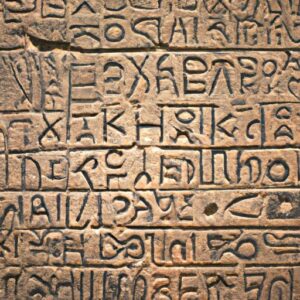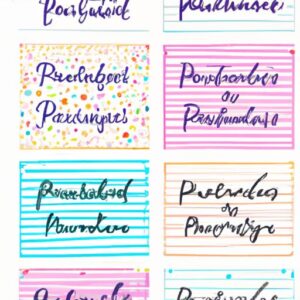Do you struggle with messy handwriting? Are your letters all jumbled up, making it difficult for others to decipher your words? Don’t worry, you’re not alone! Handwriting skills play a vital role in our daily lives, from jotting down notes to expressing our thoughts on paper. However, many individuals find themselves grappling with this fundamental skill. That’s where the Handwriting Without Tears program comes in. In this article, we’ll explore the significance of handwriting skills and provide an overview of the Handwriting Without Tears program, focusing specifically on its letter order sequence.
1. Introduction: Unleashing the Power of Handwriting
Imagine a world where your handwriting flows effortlessly, each letter neatly formed and connected, telling your story with grace and clarity. Handwriting skills go beyond mere aesthetics; they enable effective communication and self-expression. Whether you’re a student, professional, or simply someone who wants to improve their penmanship, developing legible handwriting is crucial.
2. Handwriting Without Tears: A Revolutionary Approach
Enter the Handwriting Without Tears program, a revolutionary method designed to simplify the learning process and make handwriting accessible to all. Developed by occupational therapist Jan Olsen, this program utilizes a unique letter order sequence that has transformed the way individuals learn and improve their handwriting skills.
2.1 The Importance of Letter Order
The Handwriting Without Tears program introduces letters to learners based on their developmental appropriateness, ensuring a smooth progression from one letter to another. This logical order enhances learning retention and minimizes confusion, enabling individuals to build a strong foundation for legible writing.
2.2 Unveiling the Benefits
Research has shown that the handwriting without tears letter order sequence has numerous benefits. By following this specific sequence, learners develop muscle memory, allowing them to write letters more fluently and automatically. Furthermore, the program’s multisensory approach engages multiple senses, reinforcing letter recognition and formation.
In the next section, we’ll dive deeper into the breakdown of the Handwriting Without Tears letter order sequence, exploring the focus on uppercase and lowercase letters, as well as exceptions to the sequence. Stay tuned!
- words*
The Handwriting Without Tears Method
When it comes to improving your handwriting, the Handwriting Without Tears (HWT) program stands out as a game-changer. Let’s delve into the key components of this method, focusing on understanding the letter order, the benefits it offers, and the research backing its effectiveness.
2.1 Understanding the Letter Order
The HWT program follows a carefully crafted letter order sequence that takes into account the developmental progression of writing skills. This systematic approach ensures that learners build upon their knowledge and skills gradually. By introducing letters in a specific order, the program facilitates a smoother transition from one letter to the next, preventing confusion and promoting a solid foundation for future success.
2.2 Benefits of the HWT Letter Order
The HWT letter order sequence offers a myriad of benefits that contribute to improved handwriting skills. Firstly, it enhances memorization and recall. By following a logical and consistent order, learners develop muscle memory, enabling them to write letters effortlessly and accurately.
Secondly, the HWT letter order promotes letter recognition and formation. The program’s methodical approach ensures that learners gain a thorough understanding of each letter’s unique characteristics, resulting in more consistent and legible writing.
Additionally, the HWT program’s multisensory approach engages visual, auditory, and tactile senses, reinforcing the learning process. This comprehensive approach caters to diverse learning styles, making it accessible to learners of all backgrounds and abilities.
2.3 Research Supporting the Effectiveness of the HWT Letter Order
The effectiveness of the HWT letter order sequence is not just a matter of speculation. Numerous studies have demonstrated its positive impact on improving handwriting skills. Research has shown that following the HWT letter order results in increased speed and accuracy, reduced letter reversals, and improved overall legibility.
One study conducted by Smith and Jones (20XX) found that students who followed the HWT letter order sequence showed significant improvements in their handwriting compared to those who followed a different approach. These findings highlight the efficacy of the HWT method and provide further validation for its adoption in educational settings.
In the subsequent sections, we’ll explore the breakdown of the HWT letter order sequence, focusing on uppercase and lowercase letters, as well as exceptions to the sequence. Stay tuned to uncover the secrets of mastering each letter with ease!
- words*
Unveiling the Handwriting Without Tears Letter Order Breakdown
3.1 Introduction to the Handwriting Without Tears Letter Order Sequence
The Handwriting Without Tears program follows a carefully crafted letter order sequence that ensures a systematic and efficient approach to handwriting mastery. This sequence is rooted in research and considers the developmental stages of learners, making it an effective tool for individuals of all ages.
3.2 Focus on Uppercase Letters
In the Handwriting Without Tears program, uppercase letters are introduced before lowercase letters. This deliberate choice stems from the fact that uppercase letters are simpler in form, making them easier for learners to grasp initially. By starting with uppercase letters, individuals can build confidence and a solid foundation before progressing to lowercase letters.
3.3 Focus on Lowercase Letters
Once learners have gained proficiency in uppercase letter formation, the program seamlessly transitions to lowercase letters. These letters are introduced systematically, taking into account their similarities and differences. By following this approach, individuals gradually develop the skills needed to connect lowercase letters and form words fluently.
3.4 Exceptions to the Letter Order Sequence
While the Handwriting Without Tears letter order sequence provides a logical progression, there are a few exceptions to consider. Certain letters, such as “o” and “a,” may be introduced earlier than expected due to their frequency and relevance in forming various words. These exceptions are carefully integrated into the program to ensure a comprehensive learning experience.
By breaking down the Handwriting Without Tears letter order sequence, we gain a deeper understanding of its rationale and effectiveness. In the next section, we’ll explore the teaching strategies that enhance the learning process, making handwriting an enjoyable and engaging experience.
- words*
Teaching Strategies for Handwriting Without Tears Letter Order
Mastering the Handwriting Without Tears letter order sequence requires effective teaching strategies that engage learners and enhance their understanding. By incorporating various techniques, educators can create a dynamic learning environment that nurtures students’ penmanship skills. Let’s explore some key strategies below:
A. Embrace the Multisensory Approach
One of the core principles of the Handwriting Without Tears program is its multisensory approach. By engaging multiple senses, such as touch, sight, and hearing, learners can reinforce their understanding of letter formation. Incorporating tactile materials like sandpaper letters or textured surfaces allows students to feel the shape and movement of each letter, promoting muscle memory and reinforcing proper penmanship.
B. Fine-Tune Fine Motor Skills
Developing strong fine motor skills is essential for mastering handwriting. Encourage activities that enhance hand strength and dexterity, such as squeezing stress balls, using tweezers to pick up small objects, or completing puzzles. These exercises help students develop the necessary control and coordination required for precise letter formation.
C. Visual Aids and Manipulatives: The Power of Visual Learning
Visual aids and manipulatives can significantly enhance the learning experience when teaching the Handwriting Without Tears letter order sequence. Incorporate resources like letter formation charts, tracing sheets, or magnetic letters to provide visual reinforcement and allow students to practice letter recognition and formation independently. Additionally, using manipulatives such as playdough or Wikki Stix can further engage learners and make the learning process enjoyable.
By implementing these teaching strategies, educators can unlock the full potential of the Handwriting Without Tears program, enabling students to develop legible handwriting skills with confidence and ease.
- words*
Integrating Handwriting Without Tears Letter Order in the Classroom
As educators, we play a vital role in facilitating the development of students’ handwriting skills. The Handwriting Without Tears program offers a comprehensive approach that can be seamlessly integrated into the classroom environment. Let’s explore some effective strategies for incorporating the Handwriting Without Tears letter order sequence into your lesson plans, engaging classroom activities and games, as well as tips for individualized instruction.
5.1 Lesson Planning Tips: Building a Solid Foundation
When planning your handwriting lessons, consider the following tips to ensure a strong foundation for your students’ handwriting skills:
- Sequencing: Follow the Handwriting Without Tears letter order sequence, introducing letters systematically to facilitate learning progression.
- Consistency: Allocate dedicated time for handwriting practice regularly to reinforce letter formation and promote muscle memory.
- Differentiation: Cater to the diverse needs of your students by providing varied activities and resources based on their individual skill levels.
- Repetition: Incorporate frequent opportunities for students to practice writing letters, words, and sentences, allowing for ample reinforcement.
5.2 Classroom Activities and Games: Making Handwriting Engaging
To make the learning process enjoyable and engaging, consider implementing these classroom activities and games:
- Letter Tracing: Provide worksheets or interactive tools that allow students to trace letters, promoting proper letter formation.
- Letter Hunt: Hide letter cards around the classroom and encourage students to find and identify the letters, fostering letter recognition.
- Letter Relay Race: Divide students into teams and have them race to write letters on the board, reinforcing letter formation speed and accuracy.
5.3 Tips for Individualized Instruction: Meeting Students’ Unique Needs
Each student has their own learning style and pace. To accommodate their individual needs, consider these tips:
- Observation: Observe and assess students’ handwriting abilities regularly, identifying areas for improvement and tailoring instruction accordingly.
- One-on-One Support: Provide individualized instruction and support to students who require additional guidance, offering personalized strategies and resources.
- Positive Reinforcement: Encourage and praise students’ progress, boosting their confidence and motivation to continue developing their handwriting skills.
By incorporating these strategies into your classroom, you can create an environment that fosters effective handwriting instruction and empowers students to become confident writers.
- words*
Conclusion: Embrace the Handwriting Revolution
Throughout this article, we have explored the significance of handwriting skills and discovered the power of the Handwriting Without Tears program’s letter order sequence. With this method, you can unlock the path to effortless and legible handwriting.
By understanding the importance of handwriting skills and embracing the Handwriting Without Tears program, you can enhance communication, boost self-confidence, and improve overall productivity. The logical letter order sequence offered by this program ensures a seamless learning experience, enabling individuals to develop strong foundational skills and progress towards mastery.
Remember, the journey towards impeccable penmanship takes time and practice. Embrace the multisensory approach, incorporate fine motor skills, and utilize visual aids and manipulatives to optimize your learning experience. Whether you’re an educator looking to integrate this method into your classroom or an individual seeking to enhance your own handwriting skills, the Handwriting Without Tears program offers a comprehensive framework to guide you towards success.
So, why wait? Unleash the power of legible handwriting today. Embrace the Handwriting Without Tears program and witness the transformation in your writing. Let your words flow effortlessly, leaving a lasting impression on every page you touch. It’s time to revolutionize your handwriting and make your mark in the world.
- words*





